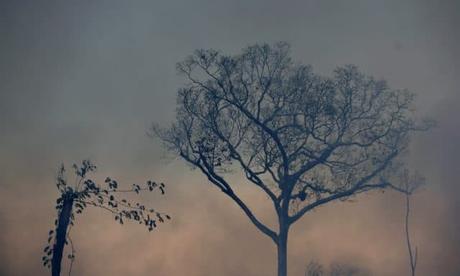Amazon deforestation is causing nearly 20 percent of its forests, which serve as one of the world’s most massive carbon sinks, to release more carbon than they absorb, an extensive study after observing a decade of carbon emissions found. It is actually releasing carbon instead of capturing it, as per the BBC.
Professor Luciana Gatti, a researcher at National Institute for Space Research (INPE), Brazil, lead a decade-long study and measured carbon by flying airplanes equipped with carbon sensors every two weeks over various parts of the forest. The results which are yet to be published showed that around 20 percent of the forest, mainly in the south-eastern section, had become an emitter of greenhouse gases instead of a carbon sink, as The Inquistr reported.

According to the BBC, the heavily logged and clear-cut south-eastern part of the forest seems to have lost its ability to absorb carbon.
Millions of trees destroyed because of logging or wildfires in recent years. The trees that are growing absorb carbon from the atmosphere, while trees that are dead emit carbon. The Amazon rainforest may change into a carbon source much faster than had been predicted due to the rapid loss of young trees, as the BBC reported.
In Brazil, recent 2019 wildfires released nearly 392,000,000 metric tons of CO2 in 2019, and that is without considering all the final numbers from the last year. The previous year’s fires in Brazil resulted in total carbon emissions equivalent to 80 percent and more than greenhouse gas emissions in Brazil in 2018, as Bloomberg reported.
“Each year is worse,” Gatti told the BBC’s Newsnight. “We observed that this area in the south-east is an important source of carbon. And it doesn’t matter whether it is a wet year or a dry year. 2017-18 was a wet year, but it didn’t make any difference.”
There could be a dramatic change to its landscape, and the future of the Amazon is troubling.
Carlos Nobre, who co-authored the study, called the observation “very worrying” because “it could be showing the beginnings of a major tipping point.” The findings point to a trend that in the next 30 years, more than 50% of the Amazon could shift from rainforest into savanna, he added, as per the BBC report.
“[The Amazon] used to be, in the 1980s and 90s, a very strong carbon sink, perhaps extracting two billion tons of carbon dioxide a year from the atmosphere,” said Nobre to the BBC, who is also a researcher at the University of Sao Paulo’s Institute for Advanced Studies and Brazil’s leading expert on the Amazon. “Today, that strength is reduced perhaps to 1-1.2bn tons of carbon dioxide a year.”
After Brazil’s president Jair Bolsonaro cracked down on clear-cutting the forest and opened up lands to loggers, ranchers, and mining operations that reversed the efforts, the number does not account for deforestation and forest fires, as both are on the rise.
The findings as per another study, recently published by the Proceedings of the National Academy of Sciences, is that indigenous and protected lands account for only 10 percent of the Amazon’s carbon emissions spread across the nine countries, as Reuters reported.
The researchers touted the indigenous lands to help combat the climate crisis. However, they can see the problem on the horizon.
“What we find is that from a carbon standpoint, protected land and indigenous territories are doing a tremendous job in buffering against losses, particularly losses associated with deforestation,” said Wayne Walker, a scientist at the Woods Hole Research Center, a U.S. climate science institute, and lead author on the study, to Reuters.
“Losses are seen from degradation associated with illegal activities, illegal mining, and illegal deforestation … to natural-related disturbance losses associated with drought and forest fires,” he told Reuters.
Nobre sees a tipping point fast approaching in spite of the efforts from indigenous communities to protect the rainforest.
“In our calculations, if we exceed that 20-25 percent of deforestation and global warming continues unabated with high emission scenarios, then the tipping point would be reached,” said Nobre to the BBC. “Today, we are at about 17 percent.”


